| Reviews & Columns |
|
Reviews DVD TV on DVD Blu-ray 4K UHD International DVDs In Theaters Reviews by Studio Video Games Features Collector Series DVDs Easter Egg Database Interviews DVD Talk Radio Feature Articles Columns Anime Talk DVD Savant Horror DVDs The M.O.D. Squad Art House HD Talk Silent DVD
|
DVD Talk Forum |
|
|
| Resources |
|
DVD Price Search Customer Service #'s RCE Info Links |
|
Columns
|
|
|
Dr. Mabuse Collection
THE MOVIES:
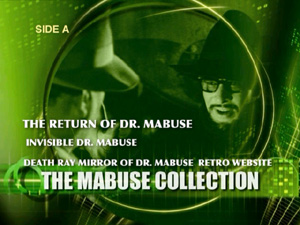
The history of the Dr. Mabuse character is a long one. Originally created by author Norbert Jacques as a knock-off of other pulp characters, the novel Dr. Mabuse, The Gambler (Dr. Mabuse, der Spieler) was adapted to the screen in 1922 by legendary director Fritz Lang. His epic silent film established Mabuse as the precursor to the comic book supervillain, controlling men's minds through hypnosis while spinning a web of crime through 1920s Germany. Lang continued exploring this character in 1933 with The Testament of Dr. Mabuse, a crime picture that finds the master criminal locked in an asylum, but somehow still controlling the German syndicates. It also connects the character to Lang's film M, drawing in his sleuth Commissioner Lohmann (then played by Otto Wernicke). Both are classics and have received excellent treatment in the DVD age.
Lang returned to the character a third time, making The Thousand Eyes of Dr. Mabuse in 1960. It was his last film, and it's often disconnected from the other Mabuse movies, considered of a lesser grade than Lang's earlier efforts. For filmgoers in the '60s, however, it may have had the most lasting impact, as it was the beginning of a whole new series produced by Artur Brauner. There were six in all, five of which are represented on The Dr. Mabuse Collection: Return of Dr. Mabuse, Invisible Dr. Mabuse, and The Death Ray Mirror of Dr. Mabuse--#s 2, 3, and 6 in the series, respectively.
When it comes to B-movies, there are A-level B-movies that transcend their original classification, and then there are the real B-movies, the low-grade options that are just cheesefests. Sometimes they are entertaining, sometimes they are not. If this collection is anything to judge by, Brauner's Mabuse series was a case of diminishing returns, and when it concluded, pulling the plug on the franchise was a mercy killing. The Death Ray Mirror of Dr. Mabuse is nearly unwatchable, having tossed out the labyrinthine criminal plots to cash-in on the then-new James Bond craze. If you watch these three movies in order, you'll be in the third hour by the time you get to Death Ray Mirror (even the title is convoluted), and you'll start to wish Mabuse would take over your will and make you one of his mindless zombies.
The case for the Mabuse franchise is not helped by the C-level DVD package put together here. Presumably working with some kind of public domain source material, the transfer quality on this disc is really bad. The German-produced films are shown here with only an English dub option, and it's hard to tell how many of the problems the movies suffer are the result of possible butchery for the U.S. drive-in circuit. Lang's Testament, for instance, was chopped up and dubbed as The Crimes of Dr. Mabuse, and when Criterion put the movie on DVD, they provided both versions to give us a historical perspective on what had happened to the flick and how it had been mistreated over the years; whether such a case can be made here, we will have to wait for a more conscientious DVD company to get their hands on the series.
The dubs themselves aren't entirely horrible, though I am curious about the funky jazz-rock score on Return of Dr. Mabuse. Was that the German score, a bid to be hip? Most of the time the voice actors are passable, but there are also times when it sounds like the performers are filling up space whenever an onscreen actor moves his or her mouth, creating unnecessary sound effects and reactions. In Return, there is even a point where someone reads the title of a book out loud. The only problem is we can see the book in an insert shot, and the title is printed in English, making it obvious when the character says a completely different name. Was no one looking at the movie when they put this together?
Even if we could forgive the lack of the original German audio, however, the picture quality also leaves much to be desired, and it gets worse and worse over the course of the films. They are all presented in full frame, and at least two of the movies--Invisible and Death Ray Mirror--don't look like they were shot that way. The pan-and-scan cropping is often quite obvious, the awkward framing cutting off heads or putting people right off the screen. All three films are put on one flipper disc, with Return playing on side A and then the other two films on Side B. There is only one menu design--and one that contains a major spoiler for the first movie, to boot!--and you can only select the film you want to watch. There are no submenus for scene selection or anything.
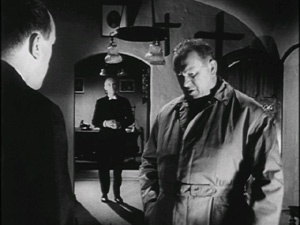
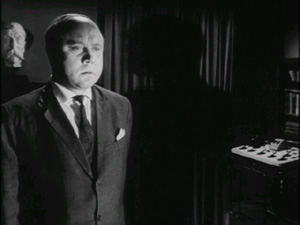
The Return of Dr. Mabuse
* The Return of Dr. Mabuse (1961): This is easily the best of the three movies. Despite not being directed by Lang and the fact that the character was not in Thousand Eyes, Commissioner Lohmann (now an inspector and played by Gert Frobe) returns, thus connecting this film to the Lang originals. Lohmann teams up with an FBI Agent, Joe Como (Lex Barker), to try to smash a deal being set up between Dr. Mabuse and the far-reaching Chicago Crime Syndicate. The plot is insane, and it may or may not actually make sense if you map it out on paper, but it moves at a brisk enough pace that it kind of works. It involves one-legged men, priests, experiments on prisoners, demented scientists, and a good looking female reporter. The fun of this film is the sheer amount of red herrings. Just about everyone Lohmann and Como encounter--and even Como himself--could be either Mabuse in disguise or a member of his organization, so it at least keeps you guessing as it makes one ludicrous leap after another.
* The Invisible Dr. Mabuse (1962): This one incorporates a little low-grade horror into the mix, and both it and Return of Dr. Mabuse actually have some surprising scenes of violence. Joe Como (again played by Barker) returns to Germany after another FBI operative is found dead in a trunk. This time, activities seem to revolve around a particular musical theatre where a play about Marie Antoinette (maybe) runs night after night, and the lead actress is being stalked by an invisible man. One of Mabuse's henchman spends the entire movie in a clown outfit, and there is even a side trip to a spa in a gothic mansion. Entertaining enough if you're locked in your house during a blizzard and have nothing else to watch.
* The Death Ray Mirror of Dr. Mabuse (1964): This is where the DVD goes completely off the rails, with the worst picture transfer of the worst possible movie. Peter Van Eyck plays Major Anders, a secret agent who travels from an unnamed country to Malta to protect Professor Larson (O.E. Hasse), who has invented a weapon that can incinerate any city anywhere in the world. This is one where I really have to wonder if there was some monkey business going on with the American release, as Eyck is in two other Mabuse movies as a different law enforcement Major, and all through Death Ray Mirror, people refer to previous cases and his obsession with Dr. Mabuse. As I noted above, this one jumps on the James Bond bandwagon, and so the barely existent plot completely disappears for long stretches while Anders either resists or gives in to the attentions of various sexy ladies. The doomsday device is just silly, and the climax is muddled and unexciting. If you made it far enough through The Dr. Mabuse Collection to select this movie, then stop where you are. Don't bother to watch it.
Then again, if this is the only presentation of these films on offer, I suggest you take a pass on the whole thing.
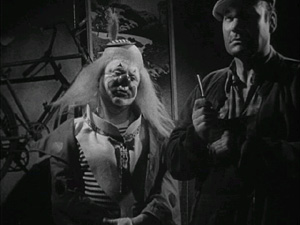
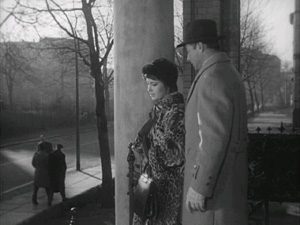
The Invisible Dr. Mabuse
THE DVD
Video:
As noted in the main review, all the movies here are in full frame, and they don't necessarily appear to have been made for that aspect ratio. The films are also in black-and-white, and I don't think they've received any restoration whatsoever.
The Return of Dr. Mabuse looks the best. Some of the picture quality is actually relatively crisp, but there are plenty of instances of surface debris and bad splicing. When it comes to The Invisible Dr. Mabuse, bad cuts and dirt and scratches are actually the norm, with the decent looking scenes being the rare exception.
The same problems persist on The Death Ray Mirror of Dr. Mabuse, but just when you thought things couldn't degrade much worse, they do. This film actually looks like it was dubbed directly from someone's bad VHS rental of the movie, with persistent fuzzy edges, flickering, and the occasional shimmer in the picture. At one point, there were even a couple of frames of solid black. Given how bad the movie is to start with, this is a case of some serious salt in my moviegoing wounds.
Sound:
You only get one audio option here, and no subtitles (not even Closed Captioning). The mix is in mono, and the Dolby logo appears on the box, but the company might consider suing for defamation of character. The sound is extremely tinny and sometimes the level of distortion renders dialogue unintelligible.
Extras:
No extras at all, which is too bad, given the rich history of the franchise. There is a "German program booklet repro" inside the DVD case, but it's really just a four-sided insert poorly copied from whatever source they dug up for it. The text is in German, and the stills are merely so-so.
FINAL THOUGHTS:
Bad movies and a bad presentation. Skip It. Seriously, I can't stress this enough. The Dr. Mabuse Collection is a crime against DVD. A good franchise gone wrong slapped onto disc in the cheapest way possible. Get the early Fritz Lang Mabuse movies and just forget these ones even exist.
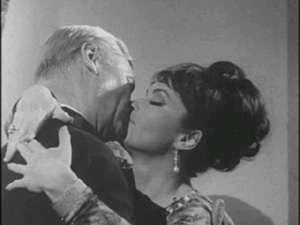
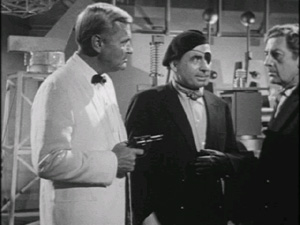
The Death Ray Mirror of Dr. Mabuse
Jamie S. Rich is a novelist and comic book writer. He is best known for his collaborations with Joelle Jones, including the hardboiled crime comic book You Have Killed Me, the challenging romance 12 Reasons Why I Love Her, and the 2007 prose novel Have You Seen the Horizon Lately?, for which Jones did the cover. All three were published by Oni Press. His most recent projects include the futuristic romance A Boy and a Girl with Natalie Nourigat; Archer Coe and the Thousand Natural Shocks, a loopy crime tale drawn by Dan Christensen; and the horror miniseries Madame Frankenstein, a collaboration with Megan Levens. Follow Rich's blog at Confessions123.com.
|
| Popular Reviews |
| Sponsored Links |
|
|
| Sponsored Links |
|
|
| Release List | Reviews | Shop | Newsletter | Forum | DVD Giveaways | Blu-Ray | Advertise |
|
Copyright 2024 DVDTalk.com All Rights Reserved. Legal Info, Privacy Policy, Terms of Use,
Manage Preferences,
Your Privacy Choices | |||||||














